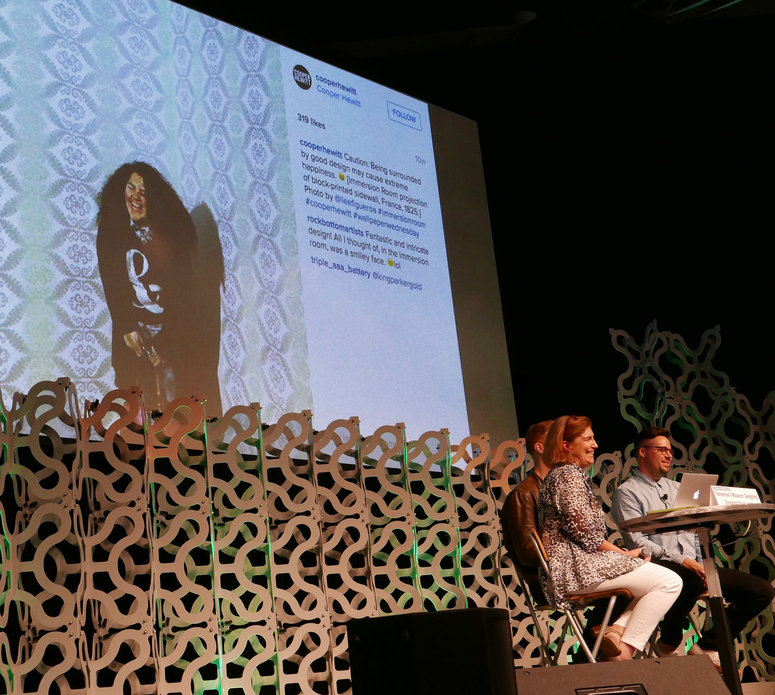- In a lively March 13th session titled “Tomorrow’s Museum: Designing Engaging Experiences” at SXSW Interactive in Austin, top tech and “experience” designers shared case studies on the use of not just digital signage and AV tools but new-gen interactive tools in some of the country’s most sophisticated new museum spaces.
Interactive tools at the Cooper Hewitt include video projection mapping that combines with a social media component to get visitors engaged.
Starting from the premise that until relatively recently, museums– especially art museums– have been slow to experiment with digital technology to create more immersive, memorable, and collaborative experiences for their visitors, the session explored some recent success stories (and failures) that feature both technology-rich and high-tech/low-tech combination solutions to “re-imagine how museum-goers interact with collections and with their fellow visitors”. Moderated by Leslie Wolke of Leslie Wolke Consulting, Nathan Adkisson, director of strategy at design firm Local Projects, and Paul Hoppe, art director at Local Projects, shared their perspective on “how the very best interactive experiences engage, educate and inspire”. Local Projects has been involved in museum design projects including Cooper Hewitt (the Smithsonian Design Museum), the Cleveland Museum of Art, the New Mexico Museum of Natural History & Science, the 9-11 Memorial Museum, and many more.
“We don’t think of ourselves as a technology company,” said Nathan Adkisson of Local Projects– that is indeed a technology company but like most companies crafting new “experiential” solutions prefers to pitch those solutions in less intimidating terms. “We help create experiences… and we use different methods, a variety of tools, to help the visitor in charge.”
Adkisson explained that it can be hard for some museum officials to understand this concept at first. But he gave the example of the 9-11 Memorial Museum in New York, where he said that the stakeholders not only understood this but put it in place fro the start, with the museum’s opening. “At the 9-11 museum, there is not a typical ‘curator’ like in most museums. All of the stories in the exhibits actually come from the hundred of people who are content creators”, he explained, pointing to the “exhibits” in the space where visitors can enter their thoughts and comments and stories as part of constantly evolving content.
With in-depth case studies from some stellar projects Adkisson, joined by Paul Hoppe, offered details of how they used technology to “put the visitor in charge”.
“Museums are not quite there, doing what Facebook or Netflix does, that is making the visit unique to each visitor,” said Hoppe, referring to how a web portal can tailor the content of the page to each visitor. But with Local Projects on board– it’s a good start, and it’s paying off with some top museums. At the New Mexico Museum of Natural History & Science, in Santa Fe, visitors can put on a “brainwave headset” that uses sensors to translate movement and eyetracking with fun, engaging graphics projected into a sharing space.

(from left to right) Nathan Adkisson, director of strategy at design firm Local Projects, Moderator Leslie Wolke of Leslie Wolke Consulting, and Paul Hoppe, art director at Local Projects, shared their perspective on “how the very best interactive experiences engage, educate and inspire”. Shown in the visuals: interactive technology at the Brooklyn Museum of Art.
Adkisson and Hoppe walked the session attendees through, with film clips, their work for the Cooper Hewitt design museum, that re-opened opened last year after closing for three years for renovation. Part of the Smithsonian in Washington DC, the newly reconfigured museum is now much more interactive. When you enter, you get a “digital pen” that is a tool to interactive with exhibits wirelessly and with touch, and can transfer your personal preferences and feedback to craft digital content tied to the exhibits. And stressing that the experience is meant to mimic for example a Facebook feed that’s tailored to each visitor, this technology in fact has led to 28% of the museum visitors visiting the museum’s web site after their visit in person– a huge jump to their web visits.In addition to “creating layers of meaning with tech tools, on top of the other exhibits”, the presenters outlined other goals typical of their designs: making the visitor feel like an expert (as opposed to being ushered through a space by anonymous experts making all the decisions); and plugging into, where it’s appropriate, the IoT (Internet of Things), so that different assets (not just a visitor’s personal screens or digital signage screens) can be on the museum network and be nodes on the visitor’s journey through the space. On that latter note, in an interesting sidebar in the presentation, Adkisson and Hoppe took the session attendees through an innovative IoT space across from the Moscone Center in San Francisco. The space is not a museum but an experimental space funded by the retailer Target, to do research on how people move digitally through spaces when objects are connected digitally. The technology there was also designed by Local Strategy, and according Adkisson and Hoppe offers them, as well as any visitor, insight into applications of this new technology that can be used in both museum and commercial spaces– or even personal (home) spaces.










